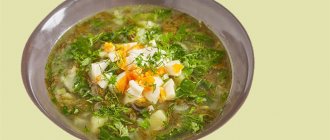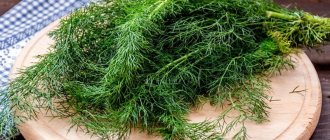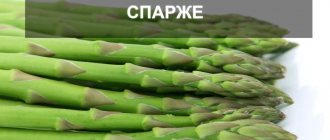Green onions are a product with a unique set of vitamins, micro- and macroelements and low calorie content. Fresh green feathers improve the taste of dishes made from meat, fish, vegetables, cereals, eggs, and dry onions are an excellent alternative to salt for those who decide to stop using it. Regular consumption of greens has a beneficial effect on the functioning of internal organs, improves appearance, and improves immunity.
From the material you will learn: how many calories are in green onions, what is their chemical composition and what benefits they bring to the body.
Calorie content of green onions
Proper, balanced nutrition requires a certain consumption of KBJU (the ratio of calories, proteins, fats and carbohydrates that enter the body with food). Therefore, it is important to know how many calories are in fresh green onions, as well as its composition. Onion feathers have a low calorie content - 19 kcal per 100 g of green mass. The protein content in feathers is 1.3 g, carbohydrates - 3.2 g, fat - 0.1 g. These are very small indicators of the energy value of a food product, so it can be freely included in the menu for those who are watching their weight or adhering to certain diets
It is important to note that the calorie content of green onions of different types and varieties differs from each other. The tubular or flat, green stems of some varieties of perennial onions have a higher calorie content:
- shallots - 72 kcal;
- leek - 36 kcal;
- batun - 30 kcal.
All varieties of green onions are a low-calorie product (up to 80 kcal per 100 g). Eating greens, which contain a storehouse of nutrients, has a positive, healing effect on the human body. The presence of a rich set of natural microelements and vitamins in the product makes it indispensable in the diet.
Did you know? The calorie content of fresh green feathers is half that of onions.
Compound
Green onions are the leaves of regular onions. They are also often called feathers. There are varieties that are grown exclusively for their feathers. The greens are harvested until the bulbs are fully ripe in the ground.
Feathers contain organic acids, antioxidants and phytoncides. The product is rich in Vitamins A, B, C, Vitamin E, Vitamin K. In addition, fresh green feathers contain minerals:
- calcium,
- silicon,
- potassium,
- carbonate,
- magnesium,
- copper,
- manganese,
- molybdenum,
- fluorine,
- zinc.
What are the benefits of green onions?
Nature has so harmoniously combined all the beneficial substances and compounds in green onions that they are almost completely absorbed by the human body, having a strengthening effect on it:
- vitamin A (retinol) - improves vision, condition of skin, nails, hair, accelerates fat metabolism and cell growth;
- vitamin C (ascorbic acid) - increases immunity, prevents diseases of the heart and circulatory system, slows down the aging of the body, reduces the likelihood of developing cancer, accelerates the healing process of wounds;
- vitamin PP (nicotinic acid) - promotes appetite and biochemical reactions in cells, increases the permeability of vascular walls;
- vitamin B1 (thiamine) - stimulates brain activity, maintains muscle tone, enriching them with oxygen, sucrose and other nutrients;
- phosphorus, calcium, magnesium, fluorine - are responsible for the strength of bones and tooth enamel, control blood sugar levels, improve the regeneration of soft tissues, and maintain potency in men;
- iron - participates in maintaining hemoglobin levels, prevents the destruction of dental tissue, supports the functioning of the brain and thyroid gland;
- zinc - normalizes the menstrual cycle and hormonal balance, has a beneficial effect on a woman’s reproductive functions, and prevents retinal detachment;
- phytoncides (volatile biologically active substances) - suppress the growth and development of bacteria, increase the body's resistance to toxins, relieve inflammation of the gums, the development of caries and stomatitis, fight colds, infectious and viral diseases, stabilize the general condition of the digestive system.
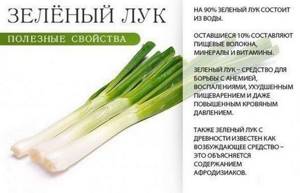
improves digestion, supports the functioning of the cardiovascular system and blood microcirculation, helps to withstand stressful situations, and acts as an antiscorbutic agent. Onions are useful for diabetes - it regulates blood sugar and stimulates the production of insulin, and also in baby food - it increases immunity, saturates the body with vitamins, and serves as a prevention of colds. Did you know? One green onion contains 16% of the daily dose of vitamin K (phylloquine), necessary for the growth and development of healthy bone tissue in the body.
Growing juicy, fragrant feathers at home is not a tricky task, but it still requires a little effort and time, which not everyone can afford. You can buy finished products at any time of the year at the market or in a store. When purchasing greens, it is important to know the criteria by which a first-class, excellent quality product is determined.
Application in cosmetology
The vegetable is often used in cosmetology. Most often it is used as the main product for preparing the following masks for hair and facial skin.
Hair Mask
The onion greens need to be crushed into a paste. This paste is applied to the hair, and then a cellophane cap is put on. The head is additionally wrapped in a towel and left for one hour. Next, the mask is washed off. This procedure can be repeated once a week.
Toning face mask
You need to mix one glass of chopped onion with one glass of cilantro. Add 20 milliliters of honey and 1 milliliter of borage to this. This composition can be applied to the neck and face for 20 minutes. Then the mask is washed off with warm water.
Pore tightening mask
You need to take two tablespoons of chopped feathers and mix with egg white. The mixture is applied to the skin for 15 minutes and then washed off. Protein helps tighten pores, and onion refreshes the skin and eliminates redness.
Features of choosing quality greens when purchasing
Onion greens are sold fresh and frozen. Feathers lose a large amount of their positive taste and nutritional properties when exposed to low temperatures (freezing). Therefore, it is recommended to purchase them only in case of emergency. When purchasing a frozen product, give preference to onions with a rich green color, straight shoots that are not bent or broken. If the onion leaves are very dark and traces of damage and spoilage are visible, then you should refuse to purchase such a product.
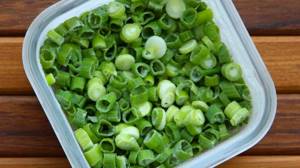
High-quality green onions should be:
- intense dark green color;
- elastic, dense, not flaccid, with no dry pen tips;
- no stains, damage, or visible signs of deterioration;
- with a clearly defined demarcation line between the white and green parts of the plant (this feature indicates the juiciness of the vegetable);
- saturated with the specific aroma of this product;
- When packaging in containers, remain dry (condensation in the container is not acceptable).
Learn about the benefits and harms of green onions for human health.
Greens that have violations of these parameters will not be tasty, high quality or nutritious.
You should refrain from buying vegetables if the following signs are expressed:
- mucus on feathers - spoilage of the product, its long-term storage;
- plaque (of different types and colors) - excessive use of fertilizers and growth stimulants, as well as drugs to increase shelf life;
- dry tip of the pen - lack of moisture during cultivation - the onion will not be so juicy;
- sluggish, flabby, yellowed feathers - the presence of onion diseases;
- moisture in a container with herbs is the first symptoms of product spoilage;
- weakly expressed characteristic aroma of onions, or its absence - grown in greenhouses using large amounts of inorganic fertilizers;
- blurred border between the white and green parts of the feather - hardness, dryness of the vegetable;
- damage to leaves (bent, broken, cracked) - bacteria may accumulate in places of defect, shelf life is limited.

This culture has a characteristic feature: the darker and richer the color of the leaves, the sharper, more pungent their taste. To avoid spoilage of the product, it is recommended to wash the greens immediately before consuming them. Regular use of green onions in the diet is a powerful source of health. But the use of this vegetable in the daily diet must be approached wisely, paying attention to some of its aspects and features.
Rules and regulations for use
In order for the product to fully benefit the body, vitality and good spirits, it is advisable to adhere to the following instructions regarding it:
- use, if possible, only fresh (adding to salads, omelettes, soups, etc.);
- to improve absorption by the body, consume with vegetable oil;
- use up in a short time (green onions are a perishable product);
- To avoid bad breath, it is advised to eat a piece of rye bread, lemon, coffee grain, cardamom or a sprig of parsley.
Important! It is not advisable for pregnant women to exceed the daily intake of onion greens: excessive consumption of the product can lead to heartburn.
It should be noted that the largest amount of nutrients and vitamins is contained in the white part of the green onion (immediately when it comes out of the onion), there are slightly less of them in the feathers of the vegetable, and there are none at all on the tips of the onion shoots (tops). Therefore, when consuming the product, it is recommended to cut off the ends of the feathers by 3-4 cm, since they do not represent any value.
For those who are healthy and do not have allergic reactions to green onions, there are no restrictions on consuming the vegetable. Eating greens, within reasonable limits, is beneficial for everyone: from small to large. However, it is advisable to exercise moderation and some caution in this. If onion belching or heartburn occurs (signs of increased acidity of gastric juice), the amount of greens consumed must be reduced.
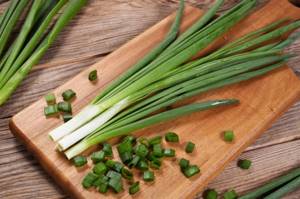
The daily intake of green onions is about 100 g. Focusing on the individual characteristics and reaction of the body, everyone can independently determine their need for this product. Having such a wide range of positive qualities and beneficial substances, green onions, unfortunately, have some restrictions on their use in the daily diet.
Benefits for women
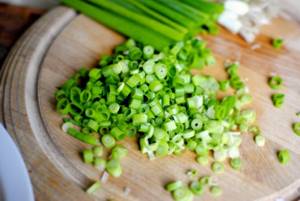
Women often refuse to eat onions, fearing their persistent smell. This is a big mistake! This vegetable is an excellent source of zinc, which is necessary to maintain reproductive function and strengthen hair and nails [6]. In addition, the product is very useful for pregnant women: it is rich in folic acid, which is necessary for the normal development of the fetus.
Harm and contraindications
The green product should be taken with caution (in minimal doses) if you have the following diseases:
- ulcerative inflammation of the gastrointestinal tract, duodenum, gastritis;
- kidney and liver diseases (hepatitis, cholecystitis, etc.);
- allergic reaction to onions;
- with hypertensive crises, persistently elevated blood pressure;
- exacerbation of chronic lung disease, bronchial asthma.
Important! When including green onions in your diet if you have acute chronic diseases, consult your doctor first.
Uncontrolled consumption of a vitamin product can lead to exacerbation of chronic diseases, so take greens in moderation, in small portions. The shelf life of the green product is short, so there is a need to take some unique measures to extend the shelf life of this vegetable. Let's take a closer look at the specifics of these events.
Use in cooking
Green feathers not only improve the taste of dishes, but also add vitamins to them. The presence of green onions makes food look more appetizing.
Green onions are used in recipes for salads, appetizers, first and second courses, fish dishes, and they prepare pies, pies and pancakes stuffed with fresh feathers. Green onions are included in meals all year round.
Green feathers are grown in winter in greenhouses or wooden boxes on windows. The optimal volume of feathers in dishes is from 30 to 100 grams. Onion appetizers are suitable for an everyday table, and for a festive one.
I recommend:
What to cook from green onions - 12 simplest and most delicious recipes
Methods for storing green onions
Green onions keep all nutrients and vitamins fresh in full; When salted, they are lost to an insignificant extent; when frozen, a little more. In this regard, it is important to extend the life of the product with minimal damage to its beneficial qualities. There are several ways to store greens:
- Fresh. This option involves storing the green mass in the refrigerator or other cool place, such as a cellar. You should immediately take into account the fact that water greatly reduces the shelf life of green onions. Based on this, it is not recommended to pre-wash the vegetable, but only wipe it with a napkin to remove excess moisture from the feathers. Damaged and spoiled leaves must be removed. Prepared products are placed in plastic bags, food containers or glass jars with lids. The shelf life in this case is no more than 5 days. Greens with a bulb last longer - up to 10 days. Containers are selected according to the size of the vegetable. It is advisable to avoid feather creases to avoid rapid spoilage of the product.
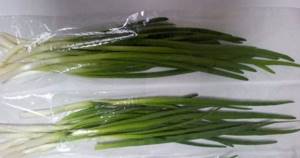
- Freezing. When using this method, the onion is washed, dried and cut into pieces. By laying it in a layer on a flat surface (tray, dish, etc.), it is pre-frozen. The onions prepared in this way are placed in containers, bags and placed in the freezer for further storage. The shelf life of the frozen product is 1 year.
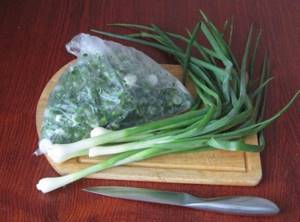
- Salting. Chopped (initially washed and dried) onions are placed in glass jars, sprinkled with salt at the rate of 200 g of salt per 1 kg of product. In this form it is stored for 6 months.
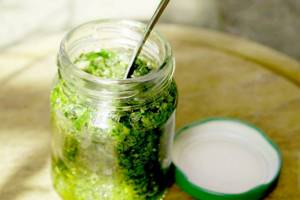
- Drying. Vegetable dryers and ovens are used for this process. In consistently warm, sunny weather, pre-prepared chopped vegetables are laid out to dry “in the sun.” The resulting dried material is packaged: in glass containers, linen bags or paper bags. Dried onions can be stored for up to 2 years.
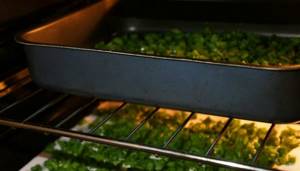
When thermally processing greens, the lion's share of beneficial properties is lost, for example: the loss of vitamin C (ascorbic acid) is 75%. In view of this, storage by preservation is not recommended and is rarely used. Green onions, having such a wide range of positive qualities, undoubtedly occupy an honorable place in the human diet. Taking into account its features, adhering to the recommendations for choosing and storing vegetables, you will certainly receive benefits and pleasure from consuming this product at any time of the year.
How to store
Without refrigeration, the shelf life of fresh green onions is approximately 2-3 days. But at a temperature of 3-4 degrees the product can be stored for several weeks.
In order for it to be stored longer, it is worth following certain rules. There is an opinion that dry greens last longer. This means there is no need to wet it.
You can wipe the feathers with a dry cloth. But if the housewife is squeamish and doesn’t like to see dirty products in the kitchen, it’s worth trying another option.
To do this, pour water into a basin and wash the greens. This removes dirt and wilted feathers. Then the feathers are dried on a cloth napkin. When the greens are dry, they are placed in the refrigerator.
Freeze chopped or whole onions. It is more convenient to use the chopped product for dressings and salads, and the whole product for first courses.
